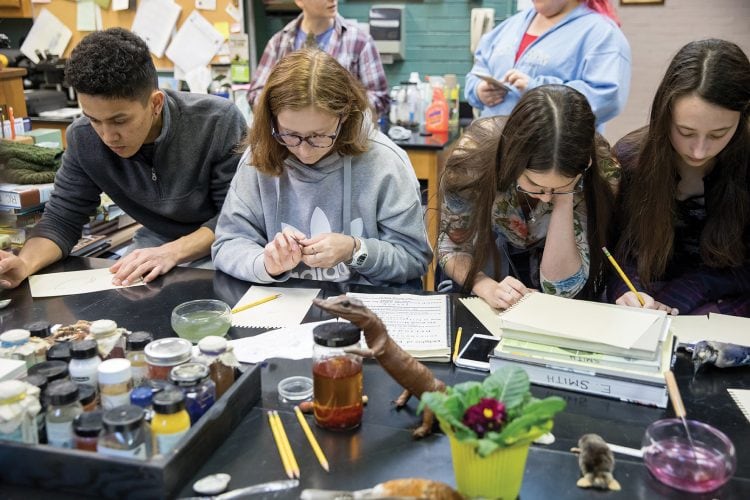Blending Art and Science: Campus exhibition utilizes Randolph's Natural History Collection to honor botanical artist

During a special workshop, Randolph students paint specimens from the College’s Natural History Collection using materials similar to those Sydney Parkinson used in the 1700s.
Campus exhibition utilizes Randolph’s Natural History Collection to honor botanical artist
Paige Edwards ’21 carefully poured a blue, powdery mixture from a small vial into a cream-colored seashell. She added a dash of gum arabic from another glass container and stirred the two substances together using a knife.

Sydney Parkinson
Once she was satisfied with the color, she picked up a thin paintbrush and began to draw her specimen—a blue bird from Randolph’s Natural History Collection.
“Now, imagine doing all of this while you’re on an old-fashioned boat that’s rocking back and forth and overcrowded with people,” Rachel Harrison ’18 told her.
Harrison was one of several students involved in creating an exhibition that utilized the College’s Natural History Collection to honor Sydney Parkinson. The Scottish botanical illustrator and natural history artist created some of the first scientific sketches of wildlife and plant life during his voyage on the H.M.S. Endeavor from 1768-71.
Harrison showed workshop participants how to mix gum arabic with minerals to create paint—just as Parkinson did 250 years ago. The project, she said, was an excellent opportunity to explore the gray area between art and science.
“The most fascinating thing I learned about Sydney Parkinson and his methods was his use of natural dyes and pigments,” Harrison said.
“Painting nature with nature—even to the point of using seashells to mix pigments together—was to me such a beautiful representation of how everything in life is connected, even objects you wouldn’t have expected.”
Emily Smith ’12, coordinator of natural history and archaeology collections at Randolph, created the exhibit to honor the 250th anniversary of Parkinson’s voyage. In addition to the painting workshop, she compiled a display in Martin Science Building featuring many of Parkinson’s sketches. It also included some specimens from the College’s Natural History Collection that Parkinson saw during his voyage—including the skeleton of a kangaroo, giant beetles, and seagulls.
“Although we know about all of these animals and plants now, these things were very strange to people in Europe at that time,” Smith said. “My hope is that this exhibit gets people thinking about what’s continuous not just in the natural world, but also in human culture.”
Smith first learned about Parkinson during an art class when she was an undergraduate at Randolph and has been researching his work ever since. She has even traveled to Oak Spring Garden Library in Upperville, Virginia, to view the only two Parkinson paintings in the United States.
“It’s been a fascinating subject to explore because there’s a lot of adventure, and, to some extent, they had a significant amount of luck,” Smith said. “Captain James Cook and Joseph Banks, who funded the expedition, tend to get more attention, but Parkinson made major contributions to the field of natural science and deserves to be recognized.”
Tags: art, biology, muhs, museum and heritage studies, museum studies, natural history collection, Randolph College Natural History and Archaeology Collections, Vita 2018 April, Vita Vol. 1 No. 3

